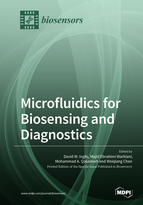Microfluidics for Biosensing and Diagnostics
A special issue of Biosensors (ISSN 2079-6374).
Deadline for manuscript submissions: closed (30 September 2019) | Viewed by 45645
Special Issue Editors
Interests: microfluidics for cell and particle separation; microfluidic physics; nanofluidics; biophotonics
Interests: microfluidics; organ-on-a-chip
Special Issues, Collections and Topics in MDPI journals
2. Tandon School of Engineering, New York University, Brooklyn, NY 11201, USA
Interests: microfluidics; biomedical micro-devices; point of care diagnostics; cancer; blood
Special Issues, Collections and Topics in MDPI journals
Special Issue Information
Dear Colleagues,
We are pleased to invite contributions to this Special Issue covering biologically relevant sensing and diagnostics with micro-scale fluidic structures. Efforts to miniaturize sensing and diagnostic devices and to integrate multiple functions into one device have caused massive growth in the field of microfluidics. This has been apparent in the volume of papers in the more recent success of many commercial devices.
The field of microfluidics is exceptionally diverse. It attracts interest and contributions from physicists, chemists and biologists, as well as electrical, mechanical, chemical, and biomedical engineers. Working in such a diverse community poses many challenges arising from different training, different terminology, and different standards and expectations for data. However, if we can overcome these pedantic differences, and communicate effectively, we may achieve great things.
With this in mind we invite contributions to this special issue from as broad a community as possible. The list of potential topics is vast, but we are particularly interested in work that elucidates how some physical or chemical phenomena is leveraged by microfluidics to improve or enable a biosensing or diagnostic application.
We will look for scientifically sound work that is presented in clear, concise, and simple writing. The work should be thoughtfully analyzed and written for the diverse microfluidics community.
Dr. David W. Inglis
Dr. Majid Ebrahimi Warkiani
Dr. Mohammad A. Qasaimeh
Dr. Weiqiang Chen
Guest Editors
Manuscript Submission Information
Manuscripts should be submitted online at www.mdpi.com by registering and logging in to this website. Once you are registered, click here to go to the submission form. Manuscripts can be submitted until the deadline. All submissions that pass pre-check are peer-reviewed. Accepted papers will be published continuously in the journal (as soon as accepted) and will be listed together on the special issue website. Research articles, review articles as well as short communications are invited. For planned papers, a title and short abstract (about 100 words) can be sent to the Editorial Office for announcement on this website.
Submitted manuscripts should not have been published previously, nor be under consideration for publication elsewhere (except conference proceedings papers). All manuscripts are thoroughly refereed through a single-blind peer-review process. A guide for authors and other relevant information for submission of manuscripts is available on the Instructions for Authors page. Biosensors is an international peer-reviewed open access monthly journal published by MDPI.
Please visit the Instructions for Authors page before submitting a manuscript. The Article Processing Charge (APC) for publication in this open access journal is 2700 CHF (Swiss Francs). Submitted papers should be well formatted and use good English. Authors may use MDPI's English editing service prior to publication or during author revisions.
Keywords
- 3D Printing
- Artificial Intelligence
- Bioconjugation
- Electrochemical
- Enzyme
- Fabrication
- Field effect transistor
- Lab-on-chip
- Lab-on-disk
- Limit of detection
- Non-specific binding
- Point of care
- Paper-based microfluidics
- Sensing
- Separation










